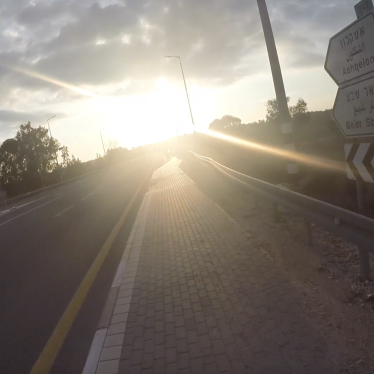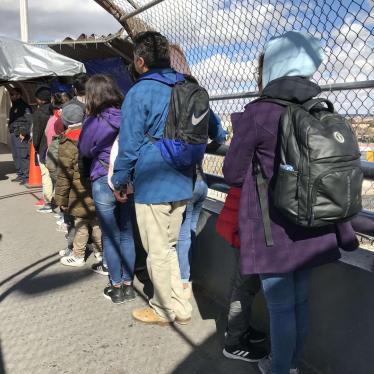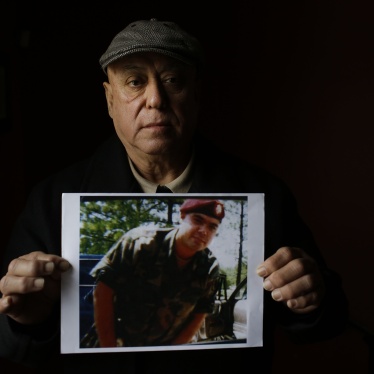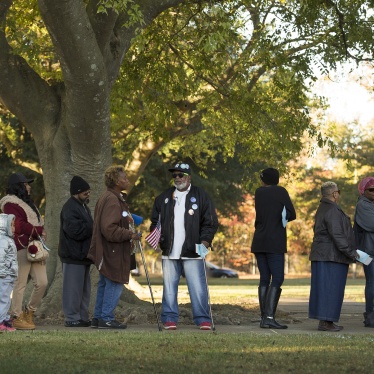Human Rights Watch Comment on Proposed Asylum Eligibility Bars
January 21, 2020
Lauren Alder Reid, Assistant Director
Office of Policy, Executive Office for Immigration Review
5107 Leesburg Pike, suite 2616
Falls Church, VA 22041
Maureen Dunn, Chief
Division of Humanitarian Affairs, Office of Policy and Strategy
US Citizenship and Immigration Services
Department of Homeland Security
20 Massachusetts Ave. NW
Washington, DC 20529-2140
Re: 84 FR 69640; EOIR Docket No. 18-0002, A.G. Order No. 4592-2019; RIN 1125-AA87, 1615-AC41; Comments in Opposition to Proposed Rulemaking: Procedures for Asylum and Bars to Asylum Eligibility
To Whom it May Concern:
I am writing on behalf of Human Rights Watch to express our strong opposition to the above-referenced Proposed Rules to amend regulations relating to eligibility for asylum published in the Federal Register on December 19, 2019.
Human Rights Watch is a nonprofit, nongovernmental human rights organization. We operate in 90 countries and have been investigating, documenting, and exposing human rights abuses around the world for more than four decades. We have published numerous reports on the human rights of migrants and asylum seekers within the US immigration system. In particular, we have analyzed extensively the ways in which the US asylum system has failed to meet US obligations under the 1967 Protocol relating to the Status of Refugees with regard to federal criminal prosecutions for unauthorized entry and reentry and with regard to the application of the “particularly serious crime” asylum bar.
For the reasons detailed in the comments that follow, the Department of Homeland Security and the Department of Justice should immediately withdraw their current proposal, and instead dedicate their efforts to ensuring that individuals fleeing persecution are granted full and fair access to asylum protections in the United States.
Thank you for the opportunity to submit comments on the Proposed Rules. Please do not hesitate to contact Grace Meng at mengg@hrw.org for further information.
Sincerely,
Nicole Austin-Hillery
Executive Director
US Program, Human Rights Watch
______________________________________________________________________________
DETAILED COMMENTS in opposition to the Proposed Rules re Procedures for Asylum and Bars to Asylum Eligibility, 84 FR 69640; EOIR Docket No. 18-0002, A.G. Order No. 4592-2019; RIN 1125-AA87, 1615-AC41
On December 19, 2019, the Department of Homeland Security (DHS) and the Department of Justice (DOJ) issued a joint set of Proposed Rules that would make three primary changes to the rules governing asylum adjudications. These changes would violate United States obligations not to return people to harm under the 1951 Convention relating to the Status of Refugees (the “Refugee Convention”) and the 1967 Protocol relating to the Status of Refugees (the “1967 Protocol”).
The United States is obligated to uphold the central provisions of the Refugee Convention by its accession to the 1967 Protocol.[1] The US government passed the Refugee Act of 1980 in order to bring the country’s laws into conformity with the Refugee Convention and 1967 Protocol, by incorporating into US law the convention’s definition of a “refugee” as a person with a well-founded fear of being persecuted on account of race, religion, nationality, membership of a particular social group, or political opinion, and by incorporating the principle of non-return (also called “nonrefoulement”), which prohibits the return of people whose lives or freedom would be threatened on account of their race, religion, nationality, membership of a particular social group, or political opinion.[2]
However, even under the existing US asylum system, the US has in recent years returned individuals to danger and serious harm, including death.[3]
The laws, regulations, and process governing asylum adjudications are already harsh. Asylum seekers bear the evidentiary burden of establishing their eligibility for asylum in the face of a complex web of laws and regulations, without the benefit of appointed counsel and often from remote detention centers where pro bono legal assistance and family and community support are extremely limited. The obstacles to being granted asylum are exceedingly high; indeed in some parts of the country and before certain immigration judges, almost no one succeeds.[4] Today, newly imposed barriers to accessing asylum in the United States are breathtaking in scope, with those seeking safety at the southern border subject to return to dangerous conditions in Mexico and an overlapping web of policies that preclude asylum eligibility for countless migrants.[5]
The first proposed set of changes adds the following seven categorical bars to asylum eligibility: (1) any conviction for a felony offense; (2) any conviction for “smuggling or harboring” under 8 U.S.C. §1324(a), even if the asylum seeker committed the offense for the purpose of bringing his or her own spouse, child or parent to safety; (3) any conviction for illegal reentry under 8 U.S.C. §1326; (4) any conviction for an offense “involving criminal street gangs,” with the adjudicator empowered to look to any evidence to determine applicability; (5) any second conviction for an offense involving driving while intoxicated or impaired; (6) any conviction or accusation of conduct for acts of battery involving a domestic relationship; (7) and any conviction for several newly defined categories of misdemeanor offenses, including any drug-related offense except for a first-time marijuana possession offense, any offense involving a fraudulent document, and fraud in public benefits.
The second section of the Proposed Rules provides a multi-factor test for immigration adjudicators to determine whether a criminal conviction or sentence is valid for the purpose of determining asylum eligibility. The third section rescinds a provision in the current rules regarding the reconsideration of discretionary asylum.
Taken together, these proposed changes constitute an unnecessary, punitive, and unlawful gutting of the asylum protections enshrined in United States and international law. Human Rights Watch submits these comments to express opposition to the entirety of the Proposed Rules and grave concerns with the administration’s continued efforts to exclude refugees from obtaining the protection the United States asylum system has long promised. We urge that the Proposed Rules be rescinded in their entirety.
Current US law already falls short of international human rights standards governing when criminal convictions should render an individual ineligible for asylum. The proposed rules exacerbate this failure by creating additional categorical criminal bars to asylum that render the phrase “particularly serious crime” meaningless and fail to provide individualized consideration of whether an individual poses a current threat to public safety.
Article 33(2) of the Refugee Convention states that protection against refoulement may not be claimed by a refugee, “who, having been convicted by a final judgment of a particularly serious crime, constitutes a danger to the community of that country.”[6] The United Nations High Commissioner for Refugees (UNHCR) maintains that a “‘particularly serious crime’ must belong to the gravest category…normally punished with long imprisonment,” and be limited “to refugees who become an extremely serious threat to the country of asylum due to the severity of crimes perpetrated by them in the country of asylum.”[7] Moreover, UNHCR has specifically noted that the particularly serious crime bar does not encompass less extreme crimes; “[c]rimes such as petty theft or the possession for personal use of illicit narcotic substances would not meet the threshold of seriousness.”[8] UNHCR’s Executive Committee has further explained that deporting a refugee under Article 33(2) “may have very serious consequences for a refugee and his immediate family members … [and therefore should only happen] in exceptional cases and after due consideration of all the circumstances.”[9]
Therefore, in accordance with international refugee law, procedures need to be in place to ensure careful application of this narrow exception.[10] Even individuals convicted of “particularly serious” crimes are guaranteed the right of an individualized hearing to establish whether or not they pose a current threat. Indeed, the “danger to the community” exception “hinges on an appreciation of a future threat from the person concerned rather than on the commission of some act in the past.”[11] Accordingly, under international refugee law, past criminality is not per se evidence of future danger.
US law already falls short of these standards.
Conviction for an offense determined to be an “aggravated felony” is considered a per se “particularly serious crime” and therefore a mandatory bar to asylum. “Aggravated felony” is a notoriously vague term, which exists only in immigration law. Originally limited to murder, weapons trafficking and drug trafficking, it has metastasized to encompass hundreds of offenses, many of them neither a felony nor aggravated.[12] Conduct that has been deemed to be an “aggravated felony” includes shoplifting and misdemeanor possession of an illicit substance with intent to distribute.[13] In many cases, individuals deemed to have an “aggravated felony” conviction under US immigration law were given short sentences or even simply probation because their conduct was not deemed to warrant more serious punishment in the criminal legal system.[14] The existing crime bars should be narrowed, not expanded.
The Proposed Rules described the increased categorization of the particularly serious crime bar as necessary because the case-by-case adjudication previously used for non-aggravated felony offenses was “inefficient.” But an individualized analysis is exactly what the Refugee Convention requires to ensure only those individuals who have been convicted of crimes that are truly serious and who present a future danger are placed at risk of refoulement.
Furthermore, many of the proposed categories of conduct include offenses that the general public would not consider “particularly serious.” The Proposed Rules could bar from protection a parent convicted of smuggling his or her own children, an individual who fled her or his country of persecution with a fake passport, and an individual with two convictions for simple possession of marijuana.
As Judge Reinhardt explained in a concurring opinion in Delgado v. Holder, a decision the Proposed Rules cite in support of the expanded bars, run-of-the-mill crimes like driving under the influence have “little in common” with other crimes the Board of Immigration Appeals has deemed particularly serious—e.g., felony menacing with a deadly weapon, armed robbery, and burglary of a dwelling in which the offender is armed or causes injury.[15] Barring individuals from asylum based on these relatively minor offenses renders the “particularly serious” part of the “particularly serious crime” bar meaningless.
The Proposed Rules turn asylum into a blunt instrument that would prevent the use of discretion where it is most needed and most effective. The existing framework for determining if an offense falls within the particularly serious crime bar already provides the latitude for asylum adjudicators to deny relief to anyone found to pose a danger to the community. Furthermore, asylees with convictions that render them inadmissible must apply for a waiver at the time of their applications for permanent residence. These measures ensure that asylees with convictions are given an opportunity to demonstrate that they have become contributing and responsible members of their communities before they become lawful permanent residents. Moreover, the existence of provisions allowing the revocation of asylum status ensures that adjudicators may continue to enforce concerns related to the safety of the community even after asylum is granted.
The proposed rule to expand the asylum bar to people who have been convicted of reentering the United States without inspection pursuant to INA § 276 directly violates the Refugee Convention’s prohibition on imposing penalties for improper entry.
Article 31(1) of the 1951 Refugee Convention states, “The Contracting States shall not impose penalties, on account of their illegal entry or presence, on refugees who, coming directly from a territory where their life or freedom was threatened in the sense of Article 1, enter or are present in their territory without authorization, provided they present themselves without delay to the authorities and show good cause for their illegal entry or presence.”[16] The protections of article 31 have been interpreted to include asylum seekers (those whose claims have not yet been adjudicated) because it cannot be determined at the point of entry whether the person qualifies as a refugee or not.[17] This prohibition is a foundational principle of the Convention because it recognizes that refugees often have little control over the place and manner in which they enter the country where they are seeking refuge and in some cases may be compelled to use false documents or otherwise break immigration laws in order to escape persecution and seek protection.
It is also not unusual that new threats crop up in countries that produce refugees. A person who may not previously have needed asylum and who was legitimately deported could subsequently encounter a threat unrelated to their previous reasons for entering the United States. The refugee protection principles at the foundation of US asylum law require the examination of new fear-of-persecution claims.
Under existing US policies, asylum seekers are routinely prosecuted for illegal entry and reentry. Even before the advent of the Trump administration’s “zero-tolerance policy,” Human Rights Watch and others have documented the frequent criminal prosecution of people who fear return to their home countries.[18] Human Rights Watch’s research indicates many people who illegally reenter the US after deportation are not driven by criminal motives, but are desperately seeking protection from harm.[19]
For example, Maira Alvarado, the wife of Joel Reyes-Isais, told Human Rights Watch in 2013 that she and her husband entered the United States together after beatings and threats from the police in Ciudad Juarez. When they were apprehended, Alvarado had just fallen from a bridge and suffered serious injuries—a broken nose, broken leg, and fractured skull—and was taken to the hospital. She said her husband told the Border Patrol, “We’re running because the police of Juarez are trying to kill us,” but he was referred for criminal prosecution and convicted of illegal reentry.[20]
Similarly, “Brenda R.” (pseudonym) told Human Rights Watch in 2012 that she fled Mexico in fear for her life after she began investigating the deaths of her two adult sons, but she entered the US three times without authorization as she was repeatedly criminally prosecuted and deported without being afforded an opportunity to apply for asylum.[21]
Such prosecutorial policies already violate US obligations under the Refugee Convention.[22] Even the Office of Inspector General for the Department of Homeland Security has stated that such prosecutions may violate US treaty obligations, even when convictions do not result in a categorical bar to asylum eligibility.[23] Imposing a categorical bar to asylum eligibility based on a conviction for illegal reentry would violate even further the United States’ obligation not to impose penalties on asylum seekers for improper entry.
Human Rights Watch has documented severe injustices in the US criminal legal system. Hundreds of thousands of people are held in custody pre-trial merely because they cannot afford bail, forcing many who might have otherwise contested their charges to plead guilty. Many face harsh sentences that do not accurately reflect the severity of their conduct, and laws and policies are routinely applied in an arbitrary and discriminatory manner, disproportionately impacting poor and minority communities.[24] Immigrants and asylum seekers in particular may not be fully informed of the potentially life-threatening immigration-related consequences of guilty pleas.
The Proposed Rules, however, fail to consider these issues in the criminal legal system by proposing to dramatically expand the definition of a “particularly serious crime” to categorically include an even wider range of offenses than is already encompassed in the definition of an “aggravated felony.” Such an enormous expansion of the “particularly serious crime” bar to asylum could lead to more refugees being denied protection and being returned to harm because of conduct that many would not consider “particularly serious.”
The Proposed Rules state that the definition of a “felony” will depend on the potential sentence, not the actual sentence imposed, thereby failing to even take into account the cases in which mitigating circumstances led a judge to impose a more lenient sentence. The Proposed Rules even forego the limited protection of due process by proposing that arrests and allegations can be sufficient to bar asylum in the categories of domestic violence and “gang-related” activity.
Human Rights Watch opposes the expansion of the “particularly serious crime” bar with regard to all of the proposed areas of conduct for all of the reasons noted above, but opposes certain categories of conduct for additional reasons as described below.
With regard to “gang-related crimes,” the Proposed Rules expansion to encompass those accused of gang involvement in the commission of minor offenses gives undue weight to methods of gang identification that have been found rife with error. Recent reports have found local law enforcement agencies around the country have created gang databases that misidentify people as gang members and rely heavily on racial profiling.[25] And as stated above, even if an individual is a former gang member, the relevant test for asylum eligibility under international human rights law is whether the person is a current threat to public safety. A categorical bar based on racially discriminatory and often inaccurate gang policing practices fails to conform to that standard.
With regard to domestic violence, incidents of domestic violence sometimes involve the arrest of both the primary perpetrator of abuse and the survivor. These “cross-arrests” do not always yield clear determinations of victim and perpetrator.[26] Authorizing asylum adjudicators to determine the primary perpetrator of domestic assault, in the absence of a judicial determination, unfairly prejudices survivors who are wrongly arrested in the course of police intervention to domestic disturbances. The exemption for asylum applicants who can demonstrate their eligibility for a waiver under section 237(a)(7)(A) of the Immigration and Nationality Act does not cure the harm to asylum seekers caused by imposition of a categorical domestic violence related bar. Rather, it converts a non-adversarial asylum proceeding into a multi-factor, highly specific inquiry into culpability based on circumstances that may be very difficult for an asylum seeker to prove—especially if proceeding without counsel and with limited English proficiency.
With regard to the inclusion of misdemeanor drug offenses, US drug laws in particular are exceedingly harsh and make felons out of many who possess drugs for personal use, rather than offering the possibility of drug treatment and rehabilitation to those who need and want it.[27] Human Rights Watch has explained in previous reports and analyses that offenses that constitute “drug trafficking” and therefore an “aggravated felony” under US immigration law should not categorically be considered a “particularly serious crime,” for the reasons summarized above.[28] Possession of drugs for personal use should not be a criminal offense, let alone constitute a “particularly serious crime” that would bar an individual from asylum.
Throughout the Proposed Rules, the agencies defend the harsh and broad nature of their proposal by pointing to the continued availability of alternative forms of relief for those precluded from asylum eligibility under the new rules. The availability of these alternative forms of relief, however—known as withholding of removal and protection under the United Nations Convention against Torture and Other Cruel, Inhuman or Degrading Treatment or Punishment (CAT)—does not nullify the harm created by the Proposed Rule’s new limits on asylum. The protections afforded by CAT and by statutory withholding of removal are limited in scope and duration, and they are harder to obtain. As a result, a Rule that limits bona fide refugees to withholding of removal and CAT protection would impose a very real harm on individuals who have come to the United States in search of protection.
First, the most serious harm that can befall an individual as a result of these Proposed Rules is removal to persecution and torture, and the existence of withholding of removal does not account for that risk. CAT and withholding protections demand a higher level of proof than asylum claims: a clear probability of persecution or torture. Thus, an individual with a well-founded fear of persecution could have a valid asylum claim but be unable to meet the higher standard under the other forms of relief and therefore could be removed to their country of origin, where they would face persecution or even death.
Even for those who meet the higher standard, withholding and CAT recipients are still subject to significant limits on their rights. For example, they have no ability to travel internationally and return to the United States. The Refugee Convention affords refugees the right to travel. Article 28 states, “Contracting States shall issue to refugees lawfully staying in their territory travel documents for the purpose of travel outside their territory.” Withholding and CAT recipients do not have access to a travel document as contemplated by article 28. By regulation, refugee travel documents are available only to asylees. Individuals granted only withholding of removal are thus effectively trapped within the United States in long-term limbo.
Withholding and CAT recipients also face permanent separation from their spouses and children. Because international travel is prohibited, these individuals cannot reconnect with their families in a third country. And they also cannot reunite with family in the United States because only asylees and refugees are eligible to petition for a spouse and children to join them as derivatives on that status. For many, this will mean that the Proposed Rules institute an effective policy of family separation.
Recently, a mother who was subject to the Migrant Protection Protocols (also known as “Remain in Mexico”) and the “Third-Country Asylum Rule” (also known as the asylum “transit ban”), making the mother ineligible for asylum, was granted withholding of removal.[29] However, the immigration judge found her young children were unable to independently establish their own claims as being more likely than not to face persecution or torture. The judge was precluded from giving the children derivative withholding based on their mother’s claim. As a result, the judge ordered the children removed even as their mother was recognized as needing protection.[30] Under the expanded bars in the Proposed Rules, these situations will certainly increase, separating families and forcing parents to return to countries where it has been established they more likely than not will face persecution and torture, rather than leaving their children on their own.
Withholding recipients likewise face hurdles in access to employment. Article 17 of the Refugee Convention states that a contracting state “shall accord to refugees lawfully staying in their territory the most favorable treatment accorded to nationals of a foreign country in the same circumstances, as regards the right to wage-earning employment.” Recipients of withholding enjoy no such right. They must apply for work authorization, and they face frequent delays in the adjudication of these applications, which often result in the loss of legal authorization to work.
And perhaps most fundamentally, there is continuing jeopardy for withholding and CAT recipients that does not exist for asylum recipients. When a noncitizen is granted asylum, the person receives a legal status. Asylum, once granted, protects an asylee against removal unless and until that status is revoked. None of these protections exists for withholding and CAT recipients. They have no access to permanent residency or citizenship. Instead, they are subject to a removal order and vulnerable to the permanent prospect of deportation to a third country and subject to potential check-ins with immigration officials where they can be made to pursue removal to third countries to which they have no connection.
Finally, Human Rights Watch writes to highlight a different hardship and disadvantage that will flow from the rule: one relating both to judicial efficiency and fairness. Neither withholding of removal nor CAT protection allow family members who are in the United States together and pursuing protection on the same basis to apply as derivatives on a principal application. As a result, family claims for those rendered ineligible for asylum by the new rules will have to be adjudicated separately, and potentially before different adjudicators even when the claims are interrelated and even when minor children may not be in a position to explain the claim at all or as sufficiently as a parent. In addition to being unjust to the affected family members (particularly children), this approach would result in gross inefficiencies, which should be avoided in a system that already contains a significant backlog of pending cases.
The US asylum system already violates international law in its overbroad, categorical definition of a “particularly serious crime,” and in its criminal prosecutions of asylum seekers. The Proposed Rules dramatically exacerbate the dissonance between US law and international law and should be rescinded in their entirety.
[1] Convention relating to the Status of Refugees (Refugee Convention), 189 U.N.T.S. 150, entered into force April 22, 1954, http://www.unhcr.org/3b66c2aa10.html; UN Protocol relating to the Status of Refugees (1967 Protocol), 606 U.N.T.S. 268, entered into force October 4, 1967. The United States acceded to the 1967 Protocol in 1968.
[2] The US incorporated the provisions of the 1967 Protocol into domestic law through the Refugee Act of 1980, Pub. L. No. 96- 212, 94 Stat. 102 (1980). As the US Supreme Court has confirmed, a primary purpose of Congress in passing the Refugee Act “was to bring United States refugee law into conformance with the 1967 United Nations Protocol.” INS v. Cardoza-Fonseca, 480 U.S. 421, 426 (1987); see also INS v. Stevic, 467 U.S. 407, 416-24 (1984) (providing a history of the incorporation of the Refugee Convention standards into US law through the 1967 Protocol and the Refugee Act of 1980).
[3] Sarah Stillman, “When Deportation is a Death Sentence,” New Yorker, January 8, 2018, https://www.newyorker.com/magazine/2018/01/15/when-deportation-is-a-death-sentence (accessed January 14, 2020); Kevin Sieff, “When death awaits deported asylum seekers,” Washington Post, December 26, 2018 https://www.washingtonpost.com/graphics/2018/world/when-death-awaits-deported-asylum-seekers/ (accessed January 14, 2020); Amanda Sperber, “Deported to Death: What It Means to ‘Go Back’ to Somalia,” Daily Beast, August 9, 2019, https://www.thedailybeast.com/deported-to-death-this-is-what-it-means-to-go-back-to-somalia (accessed January 14, 2020).
[4] Transactional Records Access Clearinghouse, ”Asylum Decisions and Denials Jump in 2018,” November 29, 2018, https://trac.syr.edu/immigration/reports/539/ (accessed January 16, 2020).
[5] Human Rights Watch, “We Can’t Help You Here”: US Returns of Asylum Seekers to Mexico, (July 2, 2019), https://www.hrw.org/report/2019/07/02/we-cant-help-you-here/us-returns-asylum-seekers-mexico; Human Rights Watch, “US: New Rule Flouts Asylum Norms,” July 15, 2019, https://www.hrw.org/news/2019/07/15/us-new-rule-flouts-asylum-norms.
[6] Refugee Convention, art. 33(2).
[7] UN High Commissioner for Refugees (UNHCR), Criminal Justice and Immigration Bill: Briefing for the House of Commons at Second Reading ¶ 7 (July 2007) [hereinafter “Briefing for House of Commons”], http://www.unhcr.org/enus/576d237f7.pdf.
[8] Ibid.
[9] UN High Commissioner for Refugees (UNHCR) Executive Committee, Conclusion No. 7 (1977). The exceptions to non-refoulement in Article 33(2) were intended to be used only as a “last resort” where “there is no alternative mechanism to protect the community in the country of asylum from an unacceptably high risk of harm.” James C. Hathaway, The Rights of Refugees under International Law (Cambridge, UK: Cambridge University Press, 2005), p. 352.
[10] The Refugee Convention and Protocol require that a refugee should be “allowed to submit evidence to clear himself, and to appeal to and be represented for the purpose before competent authority or a person or persons specially designated by the competent authority.” Ibid., art. 32(2). An individualized determination must occur before deportation, during which states must weigh two elements: 1) that a refugee has been convicted of a particularly serious crime and 2) that he or she constitutes a danger to the community. James C. Hathaway, The Rights of Refugees under International Law, pp. 344-351; Rene Bruin and Kees Wouters, "Terrorism and the Non-derogability of Non-refoulement," International Journal of Refugee Law, vol. 15, no. 1 (2003), p. 18. With regard to the first prong of the inquiry, the determination of a particularly serious crime cannot be merely rhetorical: It requires that the crime in question be distinguished from other crimes. The "particularly serious crime" exception in Article 33(2) is presumed to require that the individual refugee be even more dangerous in order to fall under this exception. See Sir Elihu Lauterpacht & Daniel Bethlehem, UNHCR, "Opinion: The Scope and Content of the Principle of Non-Refoulement," June 20, 2001, paragraph 147 ("Article 33(2) indicates a higher threshold than Article 1F . . .") With regard to the second prong, a government must separately assess the danger the individual poses to the community: “A judgment on the potential danger to the community necessarily requires an examination of the circumstances of the refugee as well as the particulars of the specific offence.” UNHCR, "Nationality Immigration and Asylum Bill 2002: UNHCR comments relating to serious criminals and statutory review," 2002, paragraph 3; UNHCR, Handbook, p. 157 ("The fact that an applicant convicted of a serious non-political crime has already served his sentence or has been granted a pardon or has benefited from amnesty is also relevant.")
[11] UNHCR, "The Scope and Content of the Principle of Non-Refoulement," paras. 147 and 164, June 20, 2001, https://www.unhcr.org/en-us/protection/globalconsult/3b33574d1/scope-content-principle-non-refoulement-opinion.html (accessed October 18, 2019) ("While past conduct may be relevant to an assessment of whether there are reasonable grounds for regarding the refugee to be a danger to the country in the future, the material consideration is whether there is a prospective danger to the security of the country").
[12] Human Rights Watch, Forced Apart: Families Separated and Immigrants Harmed by United States Deportation Policy (2007), https://www.hrw.org/reports/2007/us0707/.
[13] Ibid. See also Human Rights Watch, A Price Too High: US Families Torn Apart by Deportations for Drug Offenses (June 16, 2015), https://www.hrw.org/report/2015/06/16/price-too-high/us-families-torn-apart-deportations-drug-offenses.
[14] Ibid.
[15] Delgado v. Holder, 648 F. 3d 1095 (9th Cir. 2011) (en banc).
[16] Refugee Convention, art. 31(1) (emphasis added).
[17] See UNHCR, “Guidelines on Applicable Criteria and Standards relating to the Detention of Asylum Seekers,” February 26, 1999, http://www.refworld.org/cgi-bin/texis/vtx/rwmain?docid=3c2b3f844 (accessed May 10, 2013).
[18] Human Rights Watch, Turning Migrants Into Criminals: The Harmful Impact of US Border Prosecutions (May 2013), https://www.hrw.org/report/2013/05/22/turning-migrants-criminals/harmful-impact-us-border-prosecutions; Human Rights First, “The Rise in Criminal Prosecutions of Asylum Seekers,” July 20, 2017, https://www.humanrightsfirst.org/resource/rise-criminal-prosecutions-asylum-seekers (accessed January 16, 2020).
[19] Human Rights Watch, Turning Migrants Into Criminals: The Harmful Impact of US Border Prosecutions (May 2013).
[20] Human Rights Watch interview with Maira Alvarado, El Paso, Texas, September 27, 2012. Human Rights Watch, Turning Migrants Into Criminals (May 2013).
[21] Human Rights Watch interview with Brenda R. (pseudonym), Pecos, Texas, September 24, 2012; court documents from United States v. [name withheld]. Human Rights Watch, Turning Migrants Into Criminals (May 2013).
[22] Human Rights Watch, Turning Migrants Into Criminals (May 2013).
[23] Office of Inspector General, US Department of Homeland Security, “Streamline: Measuring Its Effect on Illegal Border Crossing,” May 15, 2015, https://www.oig.dhs.gov/assets/Mgmt/2015/OIG_15-95_May15.pdf (accessed January 16, 2020).
[24] Human Rights Watch Submission to the United Nations Human Rights Council’s Universal Periodic Review of the United States of America, October 3, 2019, https://www.hrw.org/news/2019/10/03/human-rights-watch-submission-united-nations-human-rights-councils-universal.
[25] Ali Winston, “You may be in California’s gang database and not even know it,” Reveal: Center for Investigative Reporting, March 23, 2016, https://www.revealnews.org/article/you-may-be-in-californias-gang-database-and-not-even-know-it/ (accessed January 16, 2020); Anita Chabria, “A routine police stop landed him on California’s gang database. Is it racial profiling?”, Los Angeles Times, May 9, 2019, https://www.latimes.com/politics/la-pol-ca-california-gang-database-calgang-criminal-justice-reform-20190509-story.html (accessed January 16, 2020); Mick Dumke, “Chicago’s Gang Database is Full of Errors – And Records We Have Prove It,” ProPublica, April 19, 2018, https://www.propublica.org/article/politic-il-insider-chicago-gang-database (accessed January 16, 2020).
[26] David Hirschel, “Making Arrests in Domestic Violence Cases: What Police Should Know, US Department of Justice, Office of Justice Programs, National Institute of Justice, In Short: Toward Criminal Justice Solutions, June 2009, https://www.ncjrs.gov/pdffiles1/nij/225458.pdf (accessed January 16, 2020); Sarah Smith, “In Connecticut, Calling for Help Carries Risks for Victims of Domestic Violence,” ProPublica, February 16, 2017, https://www.propublica.org/article/in-connecticut-calling-for-help-carries-risks-victims-of-domestic-violence (accessed January 16, 2020).
[27] Human Rights Watch, Every 25 Seconds: The Human Toll of Criminalizing Drug Use in the United States (October 12, 2016), https://www.hrw.org/report/2016/10/12/every-25-seconds/human-toll-criminalizing-drug-use-united-states.
[28] Human Rights Watch, A Price Too High: US Families Torn Part by Deportations for Drug Offenses (June 16, 2015).
[29] US Department of Homeland Security, “DHS and DOJ Issue Third-Country Asylum Rule,” July 15, 2019, https://www.dhs.gov/news/2019/07/15/dhs-and-doj-issue-third-country-asylum-rule (accessed January 16, 2020).
[30] Adolfo Flores, “An Immigrant Woman Was Allowed to Stay in the US – But Her Three Children Have a Deportation Order,” December 21, 2019, Buzzfeed News, https://www.buzzfeednews.com/article/adolfoflores/an-immigrant-woman-was-allowed-to-stay-in-the-us-but-not (accessed January 16, 2020).
Your tax deductible gift can help stop human rights violations and save lives around the world.
Region / Country
Most Viewed
-
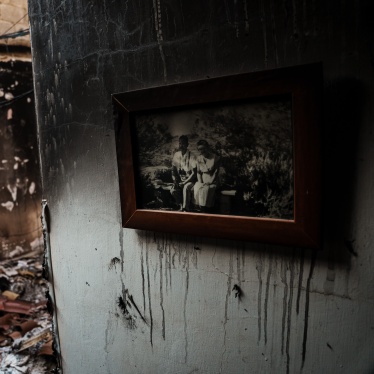
-
July 17, 2024
“I Can’t Erase All the Blood from My Mind”

-
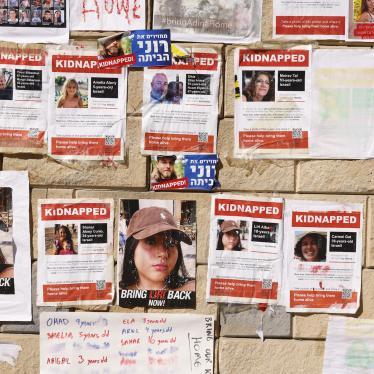
-
June 14, 2018
Leave No Girl Behind in Africa

-
